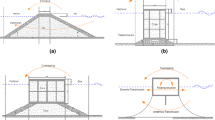Abstract
In this study, the method developed by Goda and Takagi in 2000 for optimal design of a vertical breakwater caisson is extended to take into account the effects of discount rate and economic damage costs due to long-term harbor shutdown and temporal stoppage of harbor operation. The effect of discount rate is important only at smaller return periods where the damage to the caisson frequently occurs. Among the various costs, the initial construction cost and the economic damage cost due to long-term harbor shutdown caused by extraordinary sliding of caissons are found to be equally important in finding the minimum expected total lifetime cost. On the other hand, the rehabilitation cost and the economic damage cost due to temporal stoppage of harbor operation caused by excessive wave overtopping are not so important in the optimal design of the breakwater. In general, in smaller water depths the optimal return period and the corresponding optimal cross-section of the caisson are determined as those yielding the minimum expected total lifetime cost, while they are determined by the allowable expected sliding distance in greater water depths.
Similar content being viewed by others
References
Burcharth, H. F. and Sørensen, J. D. (2000). “The PIANC safety factor system for breakwaters.” Proc. Int. Conf. Coastal Structures’ 99, A. A. Balkema, Spain, pp. 1125–1144.
Burcharth, H. F. and Sørensen, J. D. (2006). “On optimum safety levels of breakwaters.” Proc. 31st PIANC Congress, Estoril, Portugal, pp. 1–15.
Burcharth, H. F., Sørensen, J. D., and Christiani, E. (1995). “Application of reliability analysis for optimal design of monolithic vertical wall breakwaters.” Proc. Int. Conf. Coastal and Port Engineering in Developing Countries, Rio de Janeiro, Brazil, pp. 1321–1336.
Delft University of Technology (1995). Ennore coal project, India, risk analysis and probabilistic modeling, Delft.
Goda, Y. (1969). Re-analysis of laboratory data on wave transmission over breakwaters, Rep. of Port and Harbour Res. Inst., Vol. 8, No. 3, pp. 3–18.
Goda, Y. (2001). “Performance-based design of caisson breakwaters with new approach to extreme wave statistics.” Coastal Engrg. J., Vol. 43, No. 4, pp. 289–316.
Goda, Y. and Takagi, H. (2000). “A reliability design method of caisson breakwaters with optimal wave heights.” Coast. Engrg. J., Vol. 42, No. 4, pp. 357–387.
Heijn, K. M. (1997). Wave transmission at vertical breakwaters, Afstudeerverslag, Technishe Universiteit Delft, Faculteit Civiele Techniek.
Hong, S. Y., Suh, K. D., and Kweon, H.-M. (2004). “Calculation of expected sliding distance of breakwater caisson considering variability in wave direction.” Coast. Engrg. J., Vol. 46, No. 1, pp. 119–140.
Kim, S.-W. and Suh, K.-D. (2006). “Application of reliability design methods to Donghae Harbor breakwater.” Coast. Engrg. J., Vol. 48, No. 1, pp. 31–57.
KMOMAF (2001). Ocean wave observation, analysis and prediction, Korea Ministry of Marine Affairs & Fisheries (in Korean).
Kweon, H.-M., Sato, K., and Goda, Y. (1997). “A 3-D random breaking model for directional spectral waves.” Proc. 3rd Int. Symp. Ocean Wave Measurement and Analysis, ASCE, Norfolk, pp. 416–430.
McKay, M. D., Beckman, R. J., and Conover, W. J. (1979). “A comparison of three methods for selecting values of input variables in the analysis of output from a computer code.” Technometrics, Vol. 21, No. 2, pp. 239–245.
OCADIJ (2002). Technical standards and commentaries for port and harbor facilities in Japan, Overseas Coastal Area Development Institute of Japan.
Shimosako, K. and Takahashi, S. (2000). “Application of deformationbased reliability design for coastal structures.” Proc. Int. Conf. Coastal Structures ′99, A. A. Balkema, Spain, pp. 363–371.
Takahashi, S., Shimosako, K., and Hanzawa, M. (2001). “Performance design for maritime structures and its application to vertical breakwaters — Caisson sliding and deformation-based reliability design.” Proc. Int. Workshop on Advanced Design of Maritime Structures in the 21st Century, Port and Harbour Res. Inst., Yokosuka, Japan, pp. 63–73.
U.S. Army Corps of Engineers. (2002). Coastal engineering manual, Engineer Manual 1110-2-1100, U.S. Army Corps of Engineers, Washington, D.C. (in 6 volumes).
Voortman, H. G., Kuijper, H. K. T., and Vrijling, J. K. (1998). “Economic optimal design of vertical breakwaters.” Proc. 26th Int. Conf. on Coastal Engrg., ASCE, Copenhagen, pp. 2124–2137.
Vrijling, J. K., Voortman, H. G., Burcharth, H. F., and Sørensen, J. D. (2000). “Design philosophy for a vertical breakwater.” Proc. Int. Conf. Coastal Structures’ 99, A. A. Balkema, Spain, pp. 631–635.
Author information
Authors and Affiliations
Corresponding author
Rights and permissions
About this article
Cite this article
Suh, KD., Kim, KS. & Kim, DL. Effects of discount rate and various costs on optimal design of caisson breakwater. KSCE J Civ Eng 14, 99–109 (2010). https://doi.org/10.1007/s12205-010-0099-3
Received:
Revised:
Accepted:
Published:
Issue Date:
DOI: https://doi.org/10.1007/s12205-010-0099-3




